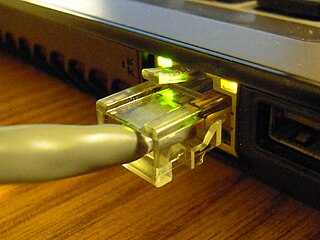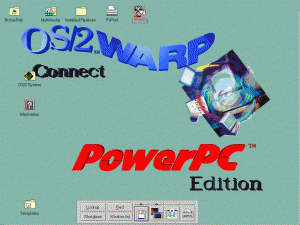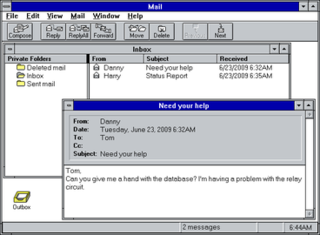Related Research Articles
AppleTalk is a discontinued proprietary suite of networking protocols developed by Apple Computer for their Macintosh computers. AppleTalk includes a number of features that allow local area networks to be connected with no prior setup or the need for a centralized router or server of any sort. Connected AppleTalk-equipped systems automatically assign addresses, update the distributed namespace, and configure any required inter-networking routing.

Ethernet is a family of wired computer networking technologies commonly used in local area networks (LAN), metropolitan area networks (MAN) and wide area networks (WAN). It was commercially introduced in 1980 and first standardized in 1983 as IEEE 802.3. Ethernet has since been refined to support higher bit rates, a greater number of nodes, and longer link distances, but retains much backward compatibility. Over time, Ethernet has largely replaced competing wired LAN technologies such as Token Ring, FDDI and ARCNET.

A local area network (LAN) is a computer network that interconnects computers within a limited area such as a residence, school, laboratory, university campus or office building. By contrast, a wide area network (WAN) not only covers a larger geographic distance, but also generally involves leased telecommunication circuits.

3Com Corporation was an American digital electronics manufacturer best known for its computer network products. The company was co-founded in 1979 by Robert Metcalfe, Howard Charney and others. Bill Krause joined as President in 1981. Metcalfe explained the name 3Com was a contraction of "Computer Communication Compatibility", with its focus on Ethernet technology that he had co-invented, which enabled the networking of computers.
StarLAN was the first IEEE 802.3 standard for Ethernet over twisted pair wiring. It was standardized by the standards association of the Institute of Electrical and Electronics Engineers (IEEE) as 802.3e in 1986, as the 1BASE5 version of Ethernet. The StarLAN Task Force was chaired by Bob Galin.
A voicemail system is a computer-based system that allows users and subscribers to exchange personal voice messages; to select and deliver voice information; and to process transactions relating to individuals, organizations, products, and services, using an ordinary phone. The term is also used more broadly to denote any system of conveying a stored telecommunications voice messages, including using an answering machine. Most cell phone services offer voicemail as a basic feature; many corporate private branch exchanges include versatile internal voice-messaging services, and *98 vertical service code subscription is available to most individual and small business landline subscribers.

Windows NT 3.1 is the first major release of the Windows NT operating system developed by Microsoft, released on July 27, 1993.

A business telephone system is a multiline telephone system typically used in business environments, encompassing systems ranging in technology from the key telephone system (KTS) to the private branch exchange (PBX).

Workplace OS is IBM's ultimate operating system prototype of the 1990s. It is the product of an exploratory research program in 1991 which yielded a design called the Grand Unifying Theory of Systems (GUTS), proposing to unify the world's systems as generalized personalities cohabitating concurrently upon a universally sophisticated platform of object-oriented frameworks upon one microkernel. Developed in collaboration with Taligent and its Pink operating system imported from Apple via the AIM alliance, the ambitious Workplace OS was intended to improve software portability and maintenance costs by aggressively recruiting all operating system vendors to convert their products into Workplace OS personalities. In 1995, IBM reported that "Nearly 20 corporations, universities, and research institutes worldwide have licensed the microkernel, laying the foundation for a completely open microkernel standard." At the core of IBM's new unified strategic direction for the entire company, the project was intended also as a bellwether toward PowerPC hardware platforms, to compete with the Wintel duopoly.

Microsoft Mail was the name given to several early Microsoft e-mail products for local area networks, primarily two architectures: one for Macintosh networks, and one for PC architecture-based LANs. All were eventually replaced by the Exchange and Outlook product lines.
Meridian Mail is one of the early all-digital voicemail systems, running on Meridian1 / SL-1 digital PBX systems from Northern Telecom.

Nortel Meridian is a private branch exchange telephone switching system. It provides advanced voice features, data connectivity, LAN communications, computer telephony integration (CTI), and information services for communication applications ranging from 60 to 80,000 lines.
The office controller was a networking concept of the early to mid-1980s. The concept was used by PABX manufacturers as the basis of families of products in which the PBX would supply data connectivity and applications along with its traditional voice services.

The AT&T UNIX PC is a Unix desktop computer originally developed by Convergent Technologies, and marketed by AT&T Information Systems in the mid- to late-1980s. The system was codenamed "Safari 4" and is also known as the PC 7300, and often dubbed the "3B1". Despite the latter name, the system had little in common with AT&T's line of 3B series computers. The system was tailored for use as a productivity tool in office environments and as an electronic communication center.

WaveLAN was a brand name for a family of wireless networking technology sold by NCR, AT&T, Lucent Technologies, and Agere Systems as well as being sold by other companies under OEM agreements. The WaveLAN name debuted on the market in 1990 and was in use until 2000, when Agere Systems renamed their products to ORiNOCO. WaveLAN laid the important foundation for the formation of IEEE 802.11 working group and the resultant creation of Wi-Fi.
Wescom Switching Incorporated was a designer and manufacturer of digital telecommunication products such as private branch exchanges (PBXs) from 1974 until its sale to Rockwell International in 1980. Rockwell continued the development and marketing of the 580 product line until the 580 technology was sold to Ditran in 1982.
CT Connect is a software product that allows computer applications to monitor and control telephone calls. This monitoring and control is called computer-telephone integration, or CTI. CT Connect implements CTI by providing server software that supports the CTI link protocols used by a range of telephone systems, and client software that provides an application programming interface (API) for telephony functions.
Windows NT is a proprietary graphical operating system produced by Microsoft, the first version of which was released on July 27, 1993. It is a processor-independent, multiprocessing and multi-user operating system.

A fiber media converter is a simple networking device that makes it possible to connect two dissimilar media types such as twisted pair with fiber optic cabling. They were introduced to the industry in the 1990s, and are important in interconnecting fiber optic cabling-based systems with existing copper-based, structured cabling systems. They are also used in metropolitan area network (MAN) access and data transport services to enterprise customers.
MS-Net, sometimes stylized as MS-NET, was an early network operating system sold by Microsoft during the earliest days of local area networking (LANs).
References
- ↑ LANStar PTE and PTE/S: Can Be Used Without Voice Features
- ↑ "Northern leaves LAN market", Computerworld, December 10, 1990